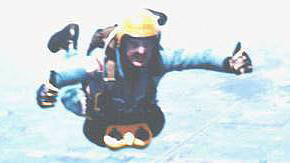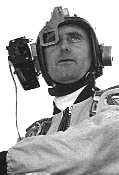|
Claude
is a President of Honour of both the FAI International Parachuting Commission
(IPC) and the Australian Parachute Federation Inc. He was involved in skydiving for more than 40
years, represented Australian skydiving at all levels of sport aviation
administration and spent a lifetime dedicated
to the advancement of sport parachuting.
As
a child, Claude jumped off his mother's laundry roof with an open umbrella and dreamt of
parachuting. In 1957 he was in a
position to live his dream, when he joined the Australian Citizen Military
Forces, 2nd Commando Company.
Making his first jump from a C-47 at Salt Ash Dropzone on the 10th June
1959; by 1962 he was an Australian parachuting
champion.
Claude has been involved in
many parachuting record breaking activities over the years and in September 1961, Claude, Hans Magnusson,
Bill Sparkes and Charl Stewart created a new Australian height and free fall
record by jumping from a turbo charged De Havilland Beaver, at a height of
23,600 feet. They delayed their parachute opening for 2 minutes and 6
seconds.
The jump was made to publicise and promote the establishment of sport parachuting in South Australia,
In the
early 60’s,
when baton passing was state of the art, Claude and five other Australians,
(Andy Keech, Colin King, Bill Molloy, Len Hunter and Beryl Blakemore) led the
world in relative work techniques. They performed a 5-way 6-person baton
pass from 13,000 feet with one minute of free fall. The only other team
to perform a six person baton pass at that time was the United States Army
Parachute Team, The Golden Knights, from 32,000 feet with more than two
minutes of free fall.
In 1962, Claude established
Southern Cross Parachutes Pty Ltd and began manufacturing parachuting accessories,
importing sport parachuting equipment and modifying surplus military
parachutes for use by sport parachutists.
Later, he conceived the
Gilstar parachute propulsion system which used only large slots (similar to the
Lemoine slot) in the canopy to achieve
the forward drive and steering, rather than removing fabric. He reasoned "The air can be
released in the desired direction without the removal of the material, so
achieving the same forward thrust without losing the area of drag against
downward movement normally lost by removing material". Jo Chitty of Paradynamics designed and
built the Gillstar as the “Argosy” canopy (arguably the best performance
round parachute canopy ever manufactured).
Claude was instrumental in
introducing many new parachuting concepts into Australia; The
"Progression by skill level" student training method, Security
Crossbow (piggyback) system, the Paraplane, the Czech PTCH Series and other parachutes.
He was a pioneer of
freefall relative work. He and one of his team mates, Hans
Magnusson, unintentionally performed the first two person “link up” in
Australia when during one of their many baton passes Hans decided to hold onto
the baton, rather than let it go when Claude took hold of it. They were
linked together holding the baton for 3,000 feet before Hans released it to Claude. The
excited reaction of the jumpers on the ground prompted Claude to include “link-ups”
in the repertoire of his display team. Americans who were performing
these same manoeuvres added more people to the link and called them 'stars'.
This type of parachuting became known as Relative Work
and is now known as Formation Skydiving.
Claude won a place on every
Australian Parachute Team from 1962 until 1968 when he gave up competition
parachuting to concentrate on coaching and to pursue his role in the
administration of sport parachuting in Australia. Parachuting
athletes from all over Australia came to Labertouche Sport Parachute Centre to
train for national and international events.
In 1966 Claude was elected
President of the Australian Parachute Federation (APF), a position which he
held continuously until the year 2001. As a coach, he developed the
APF's Minimum Training Programs and many other training procedures. He
was the creator of the present-day APF instructor examination system and the
source of much of the material in the APF Parachute Instructor Manual.
As a result of his foresight and sustained effort, the APF owns a
million-dollar plus building in the Australian Capital Territory.
During his 40 years with the
APF, Claude served in many positions, including Secretary, National Safety
Officer, National Coach, Acting Executive Director and Chairman of the
Board. He is a Fellow of both the Australian Society of Sport Administrators
and the Confederation of Australian Sport. He served two terms on the
Board of the Confederation of Australian Sport. He managed Southern Cross Parachutes Pty
Ltd for 25 years and operated Labertouche
Sport Parachute Centre for 18 years.
His efforts on behalf of
sport parachuting and sport aviation have earned him many honors and awards,
including: the Order of Australia Medal, the Fédération Aéronautique
Internationale Air Sports Medal, a Confederation of Australian Sport -
Fellowship Award, the Royal Federation of Aero Clubs of Australia Award, and
he is one of four skydivers designated “Master of Sport Parachuting” by
the Australian Parachute Federation. He was designated a
"Companion of Honor of the
Fédération Aéronautique
Internationale" in 2003.
As inaugural President of
the IPC Canopy Formation Committee, Claude played a leading role in the
development of canopy formation competition parachuting around the world.
He
has been active in
the organisation of three World Parachuting Championships and two International
Parachuting Competitions. He was the organiser of six Australian Parachute
Championships, numerous local competitions and judged 139 parachuting
competitions, 57 of those as Chief Judge. He was a member of the
International Jury at 38 first category FAI international parachuting
competitions, 28 of them World Championships.
When
the Victorian Skydiving
League decided to create an annual award similar to the Australian Rules football Brownlow
Medal, the League named it the Gillard Medal.
Claude played a leading role
in the development of the Australian Sport Aviation Confederation and was
inaugural President of that body. He was President of the FAI
International Parachuting Commission for six years and represented
Australian sport aviation as Australian Vice President of the Fédération
Aéronautique Internationale for 10 years. In that role he was
President of the Jury for the London to Sydney Centennial Air Race 2001.
As Chairman of the FAI-2000
Workgroup he played a leading role in the recent reformation of the
Fédération Aéronautique Internationale. He was active in the
development of the World Air Games and the inclusion of parachuting in the
World (Athletic) Games and continues to press for the inclusion of skydiving
in the Olympic Games.
As president of the
International Parachuting Commission, he brought about the consolidation of
four world championship events into one large ‘Mondial’ Championship and
arranged for the Internet links between the IPC and the grass roots jumpers.
Claude Gillard’s guidance
and dedication to the sport of skydiving has helped bring it to the
international newsrooms. Its increasing popularity has been
greatly assisted by Claude’s hard work and commitment. When
Claude began skydiving, Australia had only 32 sport parachutists. In the
year 2001, Australia had 85,000 people taking to the skies for their first
jump.
Many of Australia's
parachuting champions over the years owe part of their success to Claude's
insistence on adopting a professional attitude, setting goals, and aiming for
personal excellence.
His
parting words to the APF when he stood down as president were “I’m proud to have
participated and contributed in some way to the betterment of our sport by
giving support to the jumpers and to raising the profile of skydiving in
Australia and the world”.
|





